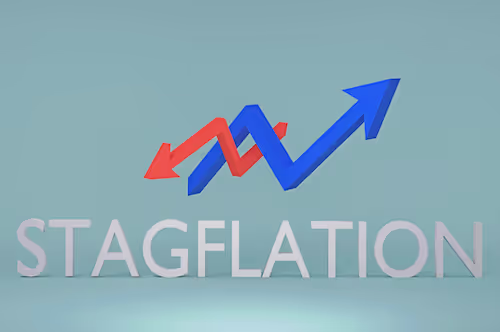Europe in 2026: risk of stagflation and how treasury allocations should adapt
Discover and decode finance and emerging technologies with Velesios, a company that empowers businesses and individuals to earn daily interest on their cash with security and flexibility.

The European economy is at a crossroads. Inflation remains stubbornly above target, while growth indicators continue to weaken. Economists are increasingly warning of a stagflation scenario—a combination of high inflation and low growth—that echoes the 1970s.
For both individuals and companies, stagflation presents a unique challenge: traditional savings accounts lose value in real terms, while riskier assets face uncertainty. Treasury management must therefore strike a careful balance between capital protection and real yield generation.
Europe’s stagflation dilemma
- Inflation in the euro area remains around 2.8%, above the European Central Bank’s (ECB) 2% target.
- Growth has slowed sharply, with Germany flirting with recession and France facing political and fiscal uncertainty.
- The ECB cut its deposit rate to 2.00% in June 2025, but is reluctant to go much further amid sticky prices.
- Energy prices and public deficits remain key risks, sustaining inflation pressure despite cooling demand.
This mix—persistent inflation + weak output—creates one of the most complex environments for investors.
Why traditional savings lose in stagflation
- Livret A and term deposits lag behind inflation. With rates at 1.7%, savers lose purchasing power each month.
- Corporate deposits often yield even less, especially when kept idle on non-remunerated accounts.
- Cash erosion accelerates in real terms, making active cash management more important than ever.
Simply holding cash is no longer “safe”; it’s a guaranteed real loss.
Smart Overnight ETF: protecting liquidity without locking funds
In stagflation, liquidity remains vital. Companies and individuals must preserve access to their cash while earning market-based returns.
- Smart Overnight ETF (LU1190417599) tracks the euro money-market rate, directly influenced by the ECB deposit rate.
- Daily interest accrual ensures performance stays aligned with short-term rates.
- No lock-up: funds can be withdrawn or reinvested anytime.
Smart Overnight acts as a modern, non-capped alternative to the Livret A, ensuring liquidity while staying indexed to central bank policy.
Amundi High Yield ESG ETF: positioning for rate normalization
In the next phase, if growth continues to weaken, the ECB may be forced to ease further. In that case, bond prices will rise, and high yield credit will benefit disproportionately.
- Amundi EUR High Yield Corporate Bond ESG ETF (LU2346257210) offers exposure to diversified corporate credit.
- Inverse sensitivity to rates: performance improves as yields fall.
- ESG integration aligns investments with responsible finance principles.
Holding both Smart Overnight and High Yield ESG thus creates a barbell strategy: liquidity and defense on one side, opportunity and yield on the other.
How Velesios helps investors adapt
- Open a securities account (individual or corporate) directly through the Velesios platform.
- Execution and custody handled in the background via Interactive Brokers.
- Reduced fees through order aggregation.
- Transparent dashboard to monitor both short- and medium-term positions.
Velesios bridges the gap between institutional-grade tools and accessible digital investment, allowing treasury to perform even in stagflationary times.
Conclusion
Stagflation is a test of discipline. It punishes inactivity and rewards diversification. By combining Smart Overnight for stability and Amundi High Yield ESG for growth potential, investors can maintain flexibility, liquidity, and real returns—whatever the next chapter of Europe’s economy brings.
FAQ: stagflation and treasury strategy
What exactly is stagflation?
A period of high inflation and weak growth, where both cash and risky assets can underperform.
Why not stay in cash?
Because inflation erodes its value; you lose purchasing power month after month.
Why use two ETFs instead of one?
They respond differently to rate cycles—Smart Overnight benefits from high rates, High Yield ESG from lower rates.
Is this approach suitable for companies?
Yes, it fits both individual investors and corporate treasuries seeking yield with liquidity.
Sources & references
- Reuters – Eurozone inflation holds above target despite slowing growth (Oct 2025)
- ECB – Monetary policy decisions, June 2025 (deposit rate 2.00%)
- Euronews – Germany and France weigh on eurozone recovery (Sept 2025)
- Service-Public – Livret A rate fixed at 1.7% since Aug 2025
- Amundi – EUR High Yield Corporate Bond ESG UCITS ETF Factsheet
If you'd like to find out more about the investment products we offer at Velesios, we're pleased to present them here.

The French paradox: record cash levels, record inaction to put that money to work

The invisible inflation: how low yields quietly erode French corporate cash

Why ESG investments are becoming a core part of corporate treasury strategy

We care about your data and only use cookies to improve your user experience. By using this website, you agree to the use of these cookies in accordance with our Privacy Policy.
.svg)